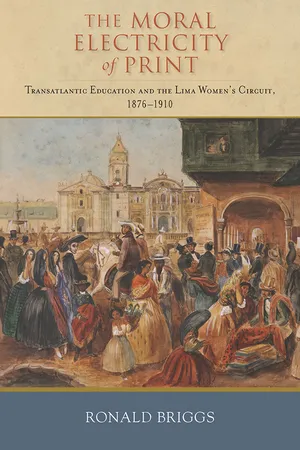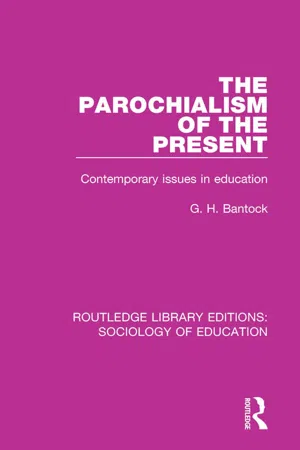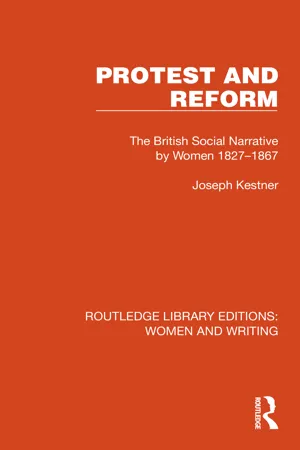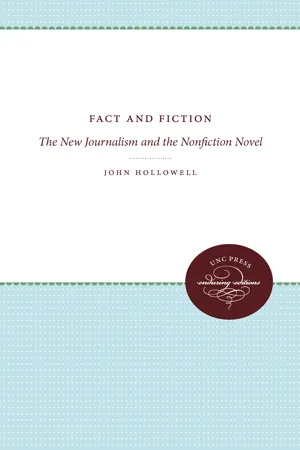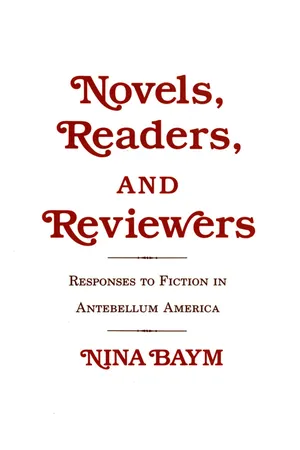Literature
Social Novel
A social novel is a work of fiction that focuses on the lives and struggles of characters within a specific social or political context. These novels often address issues such as class, poverty, inequality, and injustice, aiming to provide insight into the human condition and provoke social change. They are known for their exploration of societal issues and their impact on individuals.
Written by Perlego with AI-assistance
Related key terms
Related key terms
1 of 4
Related key terms
1 of 3
6 Key excerpts on "Social Novel"
- eBook - ePub
- Raymond Williams(Author)
- 2013(Publication Date)
- Parthian Books(Publisher)
We now commonly make this distinction between ‘social’ and ‘personal’ novels; indeed in one way we take this distinction of interest for granted. By looking at some examples, the substantial issue may be made clear. There are now two main kinds of ‘social’ novel. There is, first, the descriptive Social Novel, the documentary. This creates, as priority, a general way of life, a particular social or working community. Within this, of course, are characters, sometimes quite carefully drawn. But what we say about such novels is that if we want to know about life in a mining town, or in a university, or on a merchant ship, or on a patrol in Burma, this is the book. In fact many novels of this kind are valuable; the good documentary is usually interesting. It is right that novels of this kind should go on being written, and with the greatest possible variety of setting. Yet the dimension that we miss is obvious: the characters are miners, dons, soldiers first; illustrations of the way of life. It is not the emphasis I have been trying to describe, in which the persons are of absolute interest in themselves, and are yet seen as parts of a whole way of living. Of all current kinds of novel, this kind, at its best, isapparently nearest to what I am calling the realist novel, but the crucial distinction is quite apparent in reading: the social-descriptive function is in fact the shaping priority.A very lively kind of Social Novel, quite different from this, is now significantly popular. The tenor, here, is not description, but the finding and materialisation of a formula about society. A particular pattern is abstracted, from the sum of social experience, and a society is created from this pattern. The simplest examples are in the field of the future-story, where the ‘future’ device (usually only a device, for nearly always it is obviously contemporary society that is being written about; indeed this is becoming the main way of writing about social experience) removes the ordinary tension between the selected pattern and normal observation. - eBook - ePub
The Moral Electricity of Print
Transatlantic Education and the Lima Women's Circuit, 1876-1910
- Ronald Briggs(Author)
- 2017(Publication Date)
- Vanderbilt University Press(Publisher)
This chapter will focus on the theoretical contribution this group of writers made to the question of the novel and the novelist’s role in society. First, I will frame their vision globally, tracing the development of the idea of the Social Novel as a reaction to a particular vision of French naturalism and particular readings of foreign authors such as Leo Tolstoy and Harriet Beecher Stowe. Conducted against the constant backdrop of debates on just how “moral” or “social” the novel should seek to be—Juan Valera versus Emilia Pardo Bazán in Spain, Walter Besant versus Henry James in Great Britain and the United States—this question and Lima’s relationship to it moves at the speed of reading and translation rather than the chronology of composition and publication dates. Lima’s combination of provincialism and connection to the global world of literature makes it possible for Stowe, whose major works had been published decades before, to share the stage with Flaubert, Pardo Bazán, and Tolstoy, who were themselves in the process of writing novels and articulating the aesthetic and social goals to which they believed the genre should aspire. Finally, all four writers combine an intensely localized American anxiety about corruption as a corrosive political force with a self-conscious vision of themselves as practitioners of a global literary form. In plots that often mimicked the educational narratives I have already explored, they proposed individual struggles as allegories or even specific remedies for inequality and injustice, always imagining their own hemisphere as the last, best hope for such remedies to take hold.Gender, I will argue, plays a role in the theory of the Social Novel similar to that already seen in biographical collections and educational writings, in which a reified traditional notion of female identity serves as a lever for vastly expanded public influence. Just as the proponents of women’s education anticipated their readers’ bias by basing their argument at least in part on women’s role in raising sons , so the Social Novel would elevate the female novelist as a moral redeemer of a society in which male-dominated politics has become hopelessly corrupt. Assiduous readers of Germaine de Staël, the novelists of the Lima group saw literature as a route around traditional barriers to women as participants in politics. This elevation of the novelist as a kind of public moral educator also depended on a synthesis of literary aesthetics and pedagogical technique. The new Social Novel was an aesthetic project aimed at eliciting precisely prescribed reactions from its readers. Thus the three theoretical arcs explored so far—ideological Americanism, gender emancipation, and the fusion of education and literary aesthetics—all play an essential role in this particular conception of the Social Novel. Written from a locus of Spanish American crisis with the full consciousness of a growing world literary market, these novels and their theories seek to create the role of novelist-teacher and to suggest or overtly argue that women are particularly well suited to exercise it. Having chosen literature as the field most open for female participation in the public sphere and having practiced and theorized a formulation of the Social Novel that turned many of the conventional stereotypes about that feminine sphere into sources of authority, the women authors of the Lima circle found their own standing bound up in the debate over what the novel should do. The stakes in the debate over the Social Novel therefore encompassed not only a way of writing they sought to popularize, but also their own status as writers and public figures.2 - eBook - ePub
The Parochialism of the Present
Contemporary issues in education
- G. H. Bantock(Author)
- 2017(Publication Date)
- Routledge(Publisher)
Chapter 2 Literature and the social sciences: with particular reference to the sociology of education I Literature is of many different kinds, from the intimately personal lyric to the epic which celebrates a national or even (as in Paradise Lost) a cosmic theme. It has many different purposes — from the desire to give delight to the intention of informing the moral consciousness. In this paper the literature which is relevant is that concerned with the interrelationships between people, one which thus overtly, or by implication at least, creates a social world. There is certainly plenty of it — practically all novels and plays and a fair amount of dramatic or narrative poetry. Indeed, only the purely introspective lyric would be quite irrelevant. Furthermore, the sort of literature of this social type is that which focuses, through its offering of characters and incidents — ‘an imitation of an action’, to use the Aristotelian phrase — the highest consciousness of the age in which it was written. We have here studies of the ‘complexities, potentialities and essential conditions of human nature’ as such nature orients itself to its fellows, conflicts or co-operates with them, loves or hates in a social world. My brief quotation is from Dr Leavis — and another way of indicating the selection of literature I am referring to would be to point to the tradition of writers he has identified in his criticism. To particularise among novelists, let us say the ‘great tradition’ of Jane Austen, George Eliot, Henry James, Joseph Conrad, D.H. Lawrence — among others, but chiefly these - eBook - ePub
Protest and Reform
The British Social Narrative by Women 1827–1867
- Joseph Kestner(Author)
- 2022(Publication Date)
- Routledge(Publisher)
1 The Social NarrativeSocial protest fiction in the nineteenth century has been recognized as a substratum of the development of the novel during the last century. Reviewers of the time observed the importance of contemporaneous subject matter and commented upon the use of research materials by such authors as Charlotte Brontë and Elizabeth Gaskell. Louis Cazamian inaugurated the careful study of this subgenre in the early twentieth century. During the last decade several studies have analyzed elements of this type of prose, such as the portrayal of the captain of industry, the use of poetry and fiction for reformist purposes, and the presentation of the poor in such literature.Considerations of the Social Novel during the nineteenth century rely on a small canon of writers: Elizabeth Gaskell, Benjamin Disraeli, Charles Kingsley, perhaps Charlotte Brontë or Charles Dickens. The tradition has been conceived as being predominantly male. A recent critic has declared: “Few women novelists of this period are active reformers (at least in their fiction), and their books are generally not the forerunners of social change” (Gorsky, “Doubters” 29). This presupposition by critics has created a distortion of the facts concerning the social narrative during the nineteenth century. Far from being the province of male writers, the reverse assertion, that it was a literary form much practiced by women, constitutes the truth. Not only were many women part of this tradition; they also entered it far earlier than their male counterparts. Women identified with the disenfranchised working classes and sought to influence legislative reform through social protest narratives that depicted conditions requiring improvement. In these narratives they were responding to the transitional nature of their historical situation. - eBook - ePub
Fact and Fiction
The New Journalism and the Nonfiction Novel
- John Hollowell(Author)
- 2017(Publication Date)
- The University of North Carolina Press(Publisher)
2 This perceived unreality of contemporary life and the problems it poses for the novelist is, of course, nothing new in American literature. Even our earliest novelists—Cooper, Hawthorne, and to an extent, Melville— complained that American society did not offer the depth and stability of cultural materials to sustain a national literature. In a 1966 paper Norman Mailer succinctly summarized this viewpoint:[American social realism] was a literature which grappled with a peculiarly American phenomenon—a tendency of American society to alter more rapidly than the ability of its artists to record that change. .. . The American phenomenon had to do with the very rate of acceleration. It was as if everything changed ten times as fast in America, and this made for extraordinary difficulty in creating a literature.3Since the beginnings of the novel in the eighteenth century, of course, it has periodically become fashionable for critics to speak of the form’s imminent death. In a 1923 essay T. S. Eliot declared that the novel had ended with Flaubert and with James. At about the same time, Spanish critic Ortega y Gasset formulated a particularly influential argument in “Notes on the Novel.”4 Ortega pointed to what he called the increasing dehumanization of art in industrialized society, and went on to proclaim that the novel was dying since it had been cut off from the middle-class roots that had originally fostered its development. In metaphors comparing the source of fiction to a mine of ore, Ortega suggested that the plots and techniques available to novelists would soon become exhausted. Although contemporary critic Louis Rubin, Jr., vehemently disagrees with the conclusion that the novel is dying, he has nonetheless ironically summarized the argument: “The novel was a nineteenth-century phenomenon which depended for its life on the breakdown of the traditional class structure, and now that the class structure is permanently fluid, . . . there is no place for the novel.”5Since about the mid-fifties, the arguments of Eliot and Ortega have been endorsed in varying degrees by influential modern critics. Some have found the suggestion of the novel’s death to be exaggerated, but have nonetheless agreed that certain possibilities for fictional realism and certain possibilities of language are reaching exhaustion. In a provocative collection of essays entitled Waiting for the End (1964), Leslie Fiedler declares that if the novel dies two root causes will be paramount: “First because the artistic faith that sustained its writers is dead, and second because the audience-need it was invented to satisfy is being better satisfied otherwise.”6 - eBook - ePub
Novels, Readers, and Reviewers
Responses to Fiction in Antebellum America
- Nina Baym(Author)
- 2018(Publication Date)
- Cornell University Press(Publisher)
Tribune: “to chronicle the horrors and suppress their moral—omit the very passages that can alone excuse such exhibitions—is the wrong way entirely” (November 24, 1843). The next month it recommended an uncensored translation of the work, commenting that “no work of the age has made a more vivid impression than this, and though its exhibitions of human depravity and villainy are horrible, almost beyond belief and endurance, yet we believe more good than evil will result from its publication” (December 28, 1843).Advocacy Novels
The kind of novel that reviewers thought the best, as we have seen in earlier chapters, was one in which the world was detachedly contemplated and hence presented to the reader as an object from which detachment was possible; such a novel was itself rather an object of contemplation than a source of excitement. When novelists like Eugene Sue or George Sand wrote novels advocating socialism or attacking marriage, they went even further in what most reviewers thought to be the wrong direction: not only did they ground their works in an interactive rather than a contemplative model of the relation between reader and text, but they aimed for specific social change as the result of such interactions. Reviewers almost unanimously felt that this use of the novel form was both inartistic and unfair: social advocacy was supposed to issue from reasoned or rhetorical argument, not from attachment to attractive characters and their exciting adventures. Yet the novel of advocacy became an increasingly prevalent, and increasingly powerful, form during the era. Where critics were usually ready to argue that a novel was improved by having more to it than its form of narrated story, now they objected to the political or religious novel as a hybrid. In no other aspect of their reviewing were critics as purely formal as in their discussions of the novel of advocacy, and in no other was their formalism as suspect.
Index pages curate the most relevant extracts from our library of academic textbooks. They’ve been created using an in-house natural language model (NLM), each adding context and meaning to key research topics.
Explore more topic indexes
Explore more topic indexes
1 of 6
Explore more topic indexes
1 of 4

